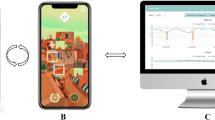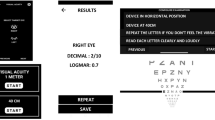Abstract
Purpose
This study aimed to study the difference in test results of online visual acuity (VA) test under different devices and screen brightness conditions and to compare online VA test with Early Treatment Diabetic Retinopathy Study (ETDRS).
Methods
Healthy volunteers with the best corrected VA of 0.0 LogMAR or higher were recruited. VAs under ETDRS were tested first, and then online VA test (the Stanford Acuity Test, StAT) visual acuities using iPad Air2 and Microsoft Surface pro4 under 50% and 100% screen brightness were performed. The VA results and the testing times were compared between different devices and screen brightness conditions.
Results
A total of 101 eyes were included in this study. The VA results measured by the StAT were better than those of ETDRS. The VA results measured at 100% screen brightness were better than those of 50% brightness (mean difference, 0.013 logMAR at most, less than 1 letter); the VA results measured by iPad Air2 were better than those of Surface pro4 (mean difference, −0.009 logMAR at most, less than 1 letter). Significantly less time was spent on VA testing under StAT than that under ETDRS.
Conclusion
The impact of screen brightness and the device on the VA results generated by online VA tests was clinically insignificant. In addition, online VA tests are found to be reliable and more time efficient than ETDRS.


Similar content being viewed by others
References
Habtamu E, Bastawrous A, Bolster NM et al (2019) Development and validation of a smartphone-based contrast sensitivity test. Transl Vis Sci Technol 8:2–11. https://doi.org/10.1167/tvst.8.5.13
Wang X, Lamoureux E, Zheng Y et al (2014) Health burden associated with visual impairment in Singapore: the Singapore epidemiology of eye disease study. Ophthalmology 121:1837–1842. https://doi.org/10.1016/j.ophtha.2014.03.017
Ou WC, Lesmes LA, Christie AH et al (2021) Normal- and low-luminance automated quantitative contrast sensitivity assessment in eyes with age-related macular degeneration. Am J Ophthalmol 226:148–155. https://doi.org/10.1016/j.ajo.2021.01.017
Ritchie A, Atamian S, Shah N et al (2021) Can visual acuity be reliably measured at home? Validation of telemedicine remote computerised visual acuity measurements. Br Irish Orthop J 17:119–126. https://doi.org/10.22599/bioj.179
Bailey IL, Lovie JE (1976) New design principles for visual acuity letter charts. Optom Vis Sci 53:740–745. https://doi.org/10.1097/00006324-197611000-00006
Mathew JA, Shah SA, Simon JW (2011) Varying difficulty of Snellen letters and common errors in amblyopic and fellow eyes. Arch Ophthalmol 129:184–187. https://doi.org/10.1001/archophthalmol.2010.369
Chen AH, Norazman F, Buari N (2012) Comparison of visual acuity estimates using three different letter charts under two ambient room illuminations. Indian J Ophthalmol 60:101–104. https://doi.org/10.4103/0301-4738.90489
Told R, Baratsits M, Garhöfer G, Schmetterer L (2013) ETDRS (Early Treatment Diabetic Retinopathy Study)-Visus. Ophthalmologe 110:960–965. https://doi.org/10.1007/s00347-013-2813-2
Koenig S, Tonagel F, Schiefer U et al (2014) Assessing visual acuity across five disease types: ETDRS charts are faster with clinical outcome comparable to Landolt Cs. Graefe’s Arch Clin Exp Ophthalmol 252:1093–1099. https://doi.org/10.1007/s00417-014-2670-y
Pang Y, Sparschu L, Nylin E (2020) Validation of an automated-ETDRS near and intermediate visual acuity measurement. Clin Exp Optom 103:663–667. https://doi.org/10.1111/cxo.13018
Gower EW, Silverman E, Cassard SD et al (2013) Barriers to attending an eye examination after vision screening referral within a vulnerable population. J Health Care Poor Underserved 24:1042–1052. https://doi.org/10.1353/hpu.2013.0134
Anjou MD, Boudville AI, Taylor HR (2013) Correcting Indigenous Australians’ refractive error and presbyopia. Clin Exp Ophthalmol 41:320–328. https://doi.org/10.1111/j.1442-9071.2012.02886.x
Burke BL, Hall RW, Dehnel PJ et al (2015) Telemedicine: pediatric applications. Pediatrics 136:e293–e308. https://doi.org/10.1542/peds.2015-1517
Dai M, Xu J, Lin J et al (2017) Willingness to use mobile health in glaucoma patients. Telemed e-Health 23:822–827. https://doi.org/10.1089/tmj.2016.0254
Ferris FL, Bailey I (1996) Standardizing the measurement of visual acuity for clinical research studies: guidelines from the Eye Care Technology Forum. Ophthalmology 103:181–182. https://doi.org/10.1016/S0161-6420(96)30742-2
Pathipati AS, Wood EH, Lam CK et al (2016) Visual acuity measured with a smartphone app is more accurate than Snellen testing by emergency department providers. Graefe’s Arch Clin Exp Ophthalmol 254:1175–1180. https://doi.org/10.1007/s00417-016-3291-4
Haupt PS (2008) Visual acuity testing in the emergency department: education and competency for emergency nurses. J Emerg Nurs 34:233–235. https://doi.org/10.1016/j.jen.2007.09.001
Stewart C, Coffey-Sandoval J, Souverein EA et al (2022) Provider-to-provider synchronous telemedical consultations in ophthalmology: advice for implementation. Digit Health 8:20552076221117744. https://doi.org/10.1177/20552076221117744
Mahajan V, Singh T, Azad C (2020) Using telemedicine during the COVID-19 pandemic. Indian Pediatr 57:652–657. https://doi.org/10.1007/s13312-020-1894-7
Liao CT, Chang WT, Yu WL, Toh HS (2020) Utility of telemedicine in the COVID-19 era. Rev Cardiovasc Med 21:583. https://doi.org/10.31083/j.rcm.2020.04.188
Lukas H, Xu C, Yu Y, Gao W (2020) Emerging telemedicine tools for remote COVID-19 diagnosis, monitoring, and management. ACS Nano 14:16180–16193. https://doi.org/10.1021/acsnano.0c08494
Bokolo A Jr (2020) Use of telemedicine and virtual care for remote treatment in response to COVID-19 pandemic. J Med Syst 44. https://doi.org/10.1007/s10916-020-01596-5
Ohannessian R, Duong TA, Odone A (2020) Global telemedicine implementation and integration within health systems to fight the COVID-19 pandemic: a call to action. JMIR Public Health Surveill 6:e18810. https://doi.org/10.2196/18810
Aslam TM, Parry NRA, Murray IJ et al (2016) Development and testing of an automated computer tablet-based method for self-testing of high and low contrast near visual acuity in ophthalmic patients. Graefe’s Arch Clin Exp Ophthalmol 254:891–899. https://doi.org/10.1007/s00417-016-3293-2
Aslam TM, Tahir HJ, Parry NRA et al (2016) Automated measurement of visual acuity in pediatric ophthalmic patients using principles of game design and tablet computers. Am J Ophthalmol 170:223–227. https://doi.org/10.1016/j.ajo.2016.08.013
Bastawrous A, Rono HK, Livingstone IAT et al (2015) Development and validation of a smartphone-based visual acuity test (peek acuity) for clinical practice and community-based fieldwork. JAMA Ophthalmol 133:930–937. https://doi.org/10.1016/j.yoph.2016.02.028
Black JM, Jacobs RJ, Phillips G et al (2013) An assessment of the iPad as a testing platform for distance visual acuity in adults. BMJ Open 3:5–7. https://doi.org/10.1136/bmjopen-2013-002730
Bokinni Y, Shah N, Maguire O, Laidlaw DAH (2015) Performance of a computerised visual acuity measurement device in subjects with age-related macular degeneration: Comparison with gold standard ETDRS chart measurements. Eye (Basingstoke) 29:1085–1091. https://doi.org/10.1038/eye.2015.94
Faria BM, Duman F, Zheng CX et al (2015) Evaluating contrast sensitivity in age-related macular degeneration using a novel computer-based test, the spaeth/richman contrast sensitivity test. Retina 35:1465–1473. https://doi.org/10.1097/IAE.0000000000000474
Kollbaum PS, Jansen ME, Kollbaum EJ, Bullimore MA (2014) Validation of an iPad test of letter contrast sensitivity. Optom Vis Sci 91:291–296. https://doi.org/10.1097/OPX.0000000000000158
Liu JL, Jason McAnany J, Wilensky JT et al (2017) M&S Smart System contrast sensitivity measurements compared with standard visual function measurements in primary open-angle glaucoma patients. J Glaucoma 26:528–533. https://doi.org/10.1097/IJG.0000000000000659
Lodhia V, Karanja S, Lees S, Bastawrous A (2016) Acceptability, usability, and views on deployment of peek, a mobile phone mhealth intervention for eye care in Kenya: qualitative study. JMIR Mhealth Uhealth 4:e30. https://doi.org/10.2196/mhealth.4746
Pang Y, Sparschu L, Wang J (2021) Repeatability of an automated ETDRS contrast threshold measurement. Ophthalmic Physiol Opt 41:896–899. https://doi.org/10.1111/opo.12829
Wisse RPL, Muijzer MB, Cassano F et al (2019) Validation of an independent web-based tool for measuring visual acuity and refractive error (the manifest versus online refractive evaluation trial): prospective open-label noninferiority clinical trial. J Med Internet Res 21:e14808. https://doi.org/10.2196/14808
Zhang Z-T, Zhang S-C, Huang X-G, Liang L-Y (2013) A pilot trial of the iPad tablet computer as a portable device for visual acuity testing. J Telemed Telecare 19:55–59. https://doi.org/10.1177/1357633X12474964
Brady CJ, Eghrari AO, Labrique AB (2015) Smartphone-based visual acuity measurement for screening and clinical assessment. JAMA 314:2682–2683
Han X, Scheetz J, Keel S et al (2019) Development and validation of a smartphone-based visual acuity test (vision at home). Transl Vis Sci Technol 8. https://doi.org/10.1167/tvst.8.4.27
Perera C, Chakrabarti R, Islam FMA, Crowston J (2015) The Eye Phone Study: reliability and accuracy of assessing Snellen visual acuity using smartphone technology. Eye (Basingstoke) 29:888–894. https://doi.org/10.1038/eye.2015.60
Piech C, Malik A, Scott LM et al (2020) The stanford acuity test: a precise vision test using Bayesian techniques and a discovery in human visual response. Proc AAAI Conf Artif Intell 34:471–479. https://doi.org/10.1609/aaai.v34i01.5384
Wang M (2020) Eye, robot: artificial intelligence dramatically improves accuracy of classic eye exam. Science 1979:6–10. https://doi.org/10.1126/science.abc4226
Bellsmith KN, Gale MJ, Yang S et al (2022) Validation of home visual acuity tests for telehealth in the COVID-19 era. JAMA Ophthalmol 140:465. https://doi.org/10.1001/jamaophthalmol.2022.0396
Virgili G, Acosta R, Bentley SA et al (2018) Reading aids for adults with low vision. Cochrane Database Syst Rev 2018. https://doi.org/10.1002/14651858.CD003303.pub4
Kakkos SK, Nicolaides AN, Geroulakos G et al (2011) Effect of computer monitor brightness on visual (subjective) carotid plaque characterization. J Clin Ultrasound 39:497–501. https://doi.org/10.1002/jcu.20871
Pan J, Sheu J, Massimo L et al (2021) Learning experience design in health professions education: a conceptual review of evidence for educators. AEM Educ Train 5. https://doi.org/10.1002/aet2.10505
Shantakumari N, Eldeeb R, Sreedharan J, Gopal K (2014) Computer use and vision-related problems among university students in Ajman, United Arab Emirate. Ann Med Health Sci Res 4:258. https://doi.org/10.4103/2141-9248.129058
Kozeis N (2009) Impact of computer use on children’s vision. Hippokratia 13:230–231
Danilova MV, Bondarko VM (2007) Foveal contour interactions and crowding effects at the resolution limit of the visual system. J Vis 7:1–18. https://doi.org/10.1167/7.2.25
Rono HK, Bastawrous A, Macleod D et al (2018) Smartphone-based screening for visual impairment in Kenyan school children: a cluster randomised controlled trial. Lancet Glob Health 6:e924–e932. https://doi.org/10.1016/S2214-109X(18)30244-4
Wang T, Huang PJ, Chen C et al (2021) A comparison of visual acuity measured by ETDRS chart and standard logarithmic visual acuity chart among outpatients. Int J Ophthalmol 14:536–540. https://doi.org/10.18240/ijo.2021.04.09
Acknowledgements
We would like to acknowledge that the Chinese government provided financial support in the form of the National Natural Science Foundation of China, the Guangdong provincial government provided financial support in the form of the Natural Science Foundation of Guangdong Province in China, and we would like to thank the financial support by Guangzhou Municipal Science and Technology Bureau in China, Health Commission of Guangdong Province in China.
Funding
This work was supported by the National Natural Science Foundation of China (No. 82271081), the Natural Science Foundation of Guangdong Province in China (No. 2022A1515010302), the Research Grant from Guangzhou Municipal Science and Technology Bureau in China (No. 202201020268), and the Research Grant from Health Commission of Guangdong Province in China (No. C2021044).
Author information
Authors and Affiliations
Corresponding authors
Ethics declarations
Ethics approval
Approval was obtained from the Ethical Review Committee of the Zhongshan Ophthalmic Center (2020KYPJ196). The procedures used in this study adhere to the tenets of the Declaration of Helsinki.
Consent to participate
Informed consent was obtained from all individual participants included in the study.
Conflict of interest
The authors declare no competing interests.
Additional information
Publisher's note
Springer Nature remains neutral with regard to jurisdictional claims in published maps and institutional affiliations.
Lu Cheng and Shi Peng are the co-first authors of the article.
Rights and permissions
Springer Nature or its licensor (e.g. a society or other partner) holds exclusive rights to this article under a publishing agreement with the author(s) or other rightsholder(s); author self-archiving of the accepted manuscript version of this article is solely governed by the terms of such publishing agreement and applicable law.
About this article
Cite this article
Cheng, L., Peng, S., Hao, H. et al. Effect of different screen brightness and devices on online visual acuity test. Graefes Arch Clin Exp Ophthalmol 262, 641–649 (2024). https://doi.org/10.1007/s00417-023-06206-x
Received:
Revised:
Accepted:
Published:
Issue Date:
DOI: https://doi.org/10.1007/s00417-023-06206-x




